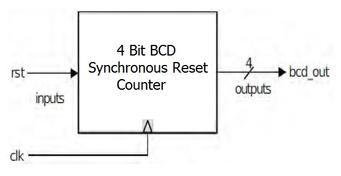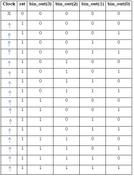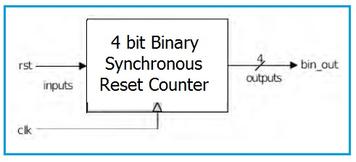4-bit Mod 13 Counter: Verilog Code and Test Bench
Advertisement
This document provides the Verilog code for a 4-bit Mod 13 counter and its corresponding test bench.
4-bit Mod 13 Counter Verilog Code
Here’s the Verilog code for a 4-bit Mod 13 counter:
`define TICK #2
module mod13Cntr(clk, reset, Q);
input clk, reset;
output [3:0] Q;
reg [3:0] Q;
//Behavioral Code for a Mod-13 counter
always @ (posedge clk) begin
if (~reset) begin
if (Q == 4'b1100) begin
Q <= `TICK 4'b0;
end else begin
Q <= `TICK Q+1;
end
end
end
always @ (posedge reset) begin
Q <= 4'b0000;
end
endmodule
Explanation:
- `define TICK #2: Defines a macro
TICKfor a delay of 2 time units. This helps in controlling the speed of the counter in simulation. - module mod13Cntr(clk, reset, Q): Declares the module
mod13Cntrwithclk(clock),reset, andQ(output) as ports. - input clk, reset: Declares
clkandresetas input signals. - output [3:0] Q: Declares
Qas a 4-bit output signal. - reg [3:0] Q: Declares
Qas a 4-bit register to store the counter’s value. - always @ (posedge clk) begin … end: This block describes the behavior of the counter on the positive edge of the clock.
- if (~reset) begin … end: Checks if the reset signal is low (active low reset).
- if (Q == 4’b1100) begin … end: Checks if the current value of
Qis 12 (4’b1100). If it is, the counter resets to 0. This makes it a Mod-13 counter. - Q <= `TICK 4’b0: Resets the counter to 0 after a delay defined by
TICK. - else begin Q <= `TICK Q+1; end: If the counter is not at 12, it increments by 1 after a delay defined by
TICK.
- always @ (posedge reset) begin … end: This block describes the reset behavior. On the positive edge of the reset signal, the counter is reset to 0.
- Q <= 4’b0000: Resets the counter to 0.
4-bit Mod 13 Counter Test Bench
The following is the test bench code for the 4-bit Mod 13 counter:
module main;
reg clk, reset;
wire [3:0] Q;
mod13Cntr dnCntr1(clk, reset, Q);
initial begin
forever begin
clk <= 0;
#5 clk <= 1;
#5 clk <= 0;
end
end
initial begin
reset = 1;
#12 reset = 0;
#170 reset = 1;
#12 reset = 0;
end
endmodule
Explanation:
- module main: Declares the test bench module named
main. - reg clk, reset: Declares
clkandresetas register signals to drive the counter. - wire [3:0] Q: Declares
Qas a wire signal to connect to the counter’s output. - mod13Cntr dnCntr1(clk, reset, Q): Instantiates the
mod13Cntrmodule, naming the instancednCntr1and connecting the signals. - initial begin forever begin … end end: This block generates a clock signal with a period of 10 time units (5 for low and 5 for high).
- clk <= 0: Sets the clock low.
- #5 clk <= 1: After a delay of 5 time units, sets the clock high.
- #5 clk <= 0: After a delay of 5 time units, sets the clock low.
- initial begin … end: This block generates a reset signal. It asserts the reset high initially, then de-asserts it, and then asserts and de-asserts it again to test the reset functionality.
- reset = 1: Sets the reset high.
- #12 reset = 0: After a delay of 12 time units, sets the reset low.
- #170 reset = 1: After a delay of 170 time units, sets the reset high.
- #12 reset = 0: After a delay of 12 time units, sets the reset low.
This test bench provides a basic stimulus to the counter, including clock and reset signals, allowing you to simulate and verify its functionality. You can add more complex checks and assertions within the test bench to thoroughly test the counter’s behavior.
Advertisement
 RF
RF





